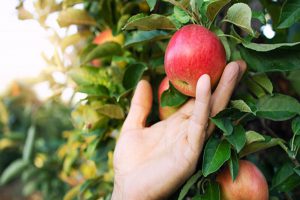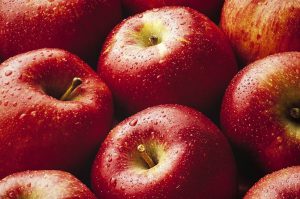There are different types of Iranian apples for export purpose, including white, red and green apples. Each of them is hand-picked with high quality, depending on the needs and requests of buyers, they can be graded from 1 to 3. Most important characteristics for high quality apples are:
Appearance: they look good with any blemishes with firm skin
Aroma: high quality apple has a good aroma that can be felt when you want to bite it!
Taste: they have a unique taste!
Our apples have all these parameters, and we can sort and pack them according to your request.

Types of Persian apples:

- Red delicious apple
- Royal gala
- Jazz apple
- Golden delicious apple
- Granny smith apple
- Kanzi apple
- Pink lady apple
- Fuji apple
Persian apples harvest time:


Harvesting at the proper time is essential to the production of quality apples. There are two types of fruits:
Non-climacteric fruits (pineapple, grape, strawberry, citrus, pepper, zucchini), which characterize by having a single point of ripeness, that is, they must be harvested just before consumption because if they are harvested green, they do not continue to ripen.
Climatic fruits (apple, pear, plum, banana, kiwi, tomato, peach,) characteristic for having two points of ripeness, that is, they continue to ripen after harvesting.
So, we conclude that to ensure maximum storage life, apples must be harvested when they have matured but not yet fully reached. Harvesting ripe fruits should be avoided as they continue to ripen in the cold storage and quickly become too soft and will no longer be suitable for sale. The strength and level of solids dissolved in apples are good indicators of maturity for use in determining the harvest time.
When transporting and moving Persian apples, all the necessary care should be taken so as not to damage the apples because even a small scratch can cause premature spoilage.
Brix meter (Brix refractometer)
Brix shows the amount of sugar in a liquid. One of the ways to detect ripening of the fruit is brix. The gardener measures the amount of the Brix in the fruit with a refractometer and if it is within the approved range attempts to harvest the fruit from the tree.

cold storage:
The Apple is a climatic fruit which means it continues to ripen after harvesting due to a gas emission called ethylene. Cold temperatures slow down ethylene production. However, apples still emit some ethylene in the cold storage and can accelerate the ripening of other products stored nearby. Therefore, it is very important to store apples separately from other products to prevent this from happening.
Commercially, Persian apples can store for months in rooms with a controlled atmosphere, delaying the ripening stimulated by ethylene. Persian Apples usually store in rooms where more carbon dioxide is collected, and air purification is better. This prevents a large increase in ethylene and prevents the fruit from ripening quickly. After leaving the warehouse the action of fruit ripening continues.
ethylene:
Ethylene gas speeds up the ripening and activates the changes in the color, texture, and flavor of the fruit. Ethylene by metabolizing pectin in the skin of the fruit makes the fruit softer. It also converts the starch in the fruit texture into monosaccharides (simpler sugars) and the fruit texture becomes softer and sweeter.
The concentration of organic acids in the fruit reduces and many of the organic substances in it are converted into chemical compounds that create the taste and smell of the fruit. In fruits like lemon, orange and Apple, ethylene improves the skin color of fruits from unripe green to yellow, orange and red. In this process ethylene first breaks down the green chlorophyll pigments in the peel of the fruit and then the yellow carotenoid pigments orange and red appear. Apples are one of those high ethylene producers, so it is important not to store them with the ethylene sensitive fruits & vegetables such as kiwi, carrots, broccoli etc.
temperature:
Apple suffers Frost at temperatures below -1.5. The optimum temperature for storing apple is 0-2°C.
Increasing the temperature from zero Celsius to 2 Celsius degrees will double the breathing action and almost halve the maintenance period. Also, the fruit will soften at 2 degrees Celsius faster than zero degrees Celsius.
Transportation:
Damage to the fruit quickly leads to spoilage, so its cargo handling requires more accuracy.
The required refrigeration temperature must be monitored and maintained continuously at all stages.
the cargo also must be protected from moisture because otherwise there is a risk of premature spoilage.
For transportation of apples, refrigerated trucks or refrigerated containers are necessary. contract with the driver and a commitment to the thermograph is very important, because a thermal shock will ruin the fruit. It`s necessary to work with a committed and more expensive driver to make sure that he didn’t turn off the car or run out of gas.

nutrition:
energy: 52 kcal
carbohydrates: 13.8 g
fat: 0.17 g
vitamin B2: 0.026 mg
vitamin B6: 0.041 mg
vitamin C: 4.6 mg
manganese: 0.035 mg
phosphorus: 11 mg
potassium: 107 mg
Sugars 10.4 g
Dietary fiber 2.4 g
Protein 0.26 g